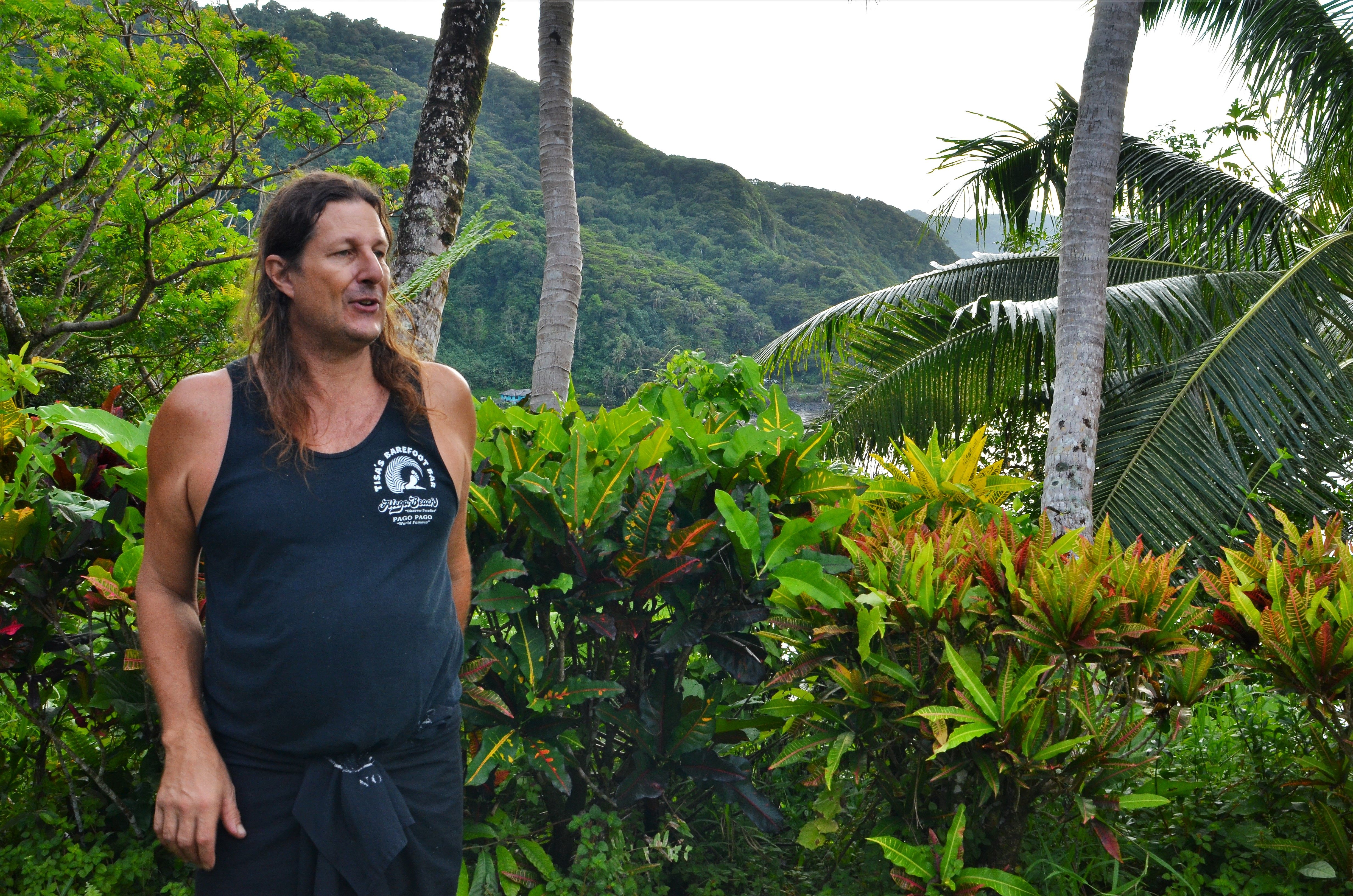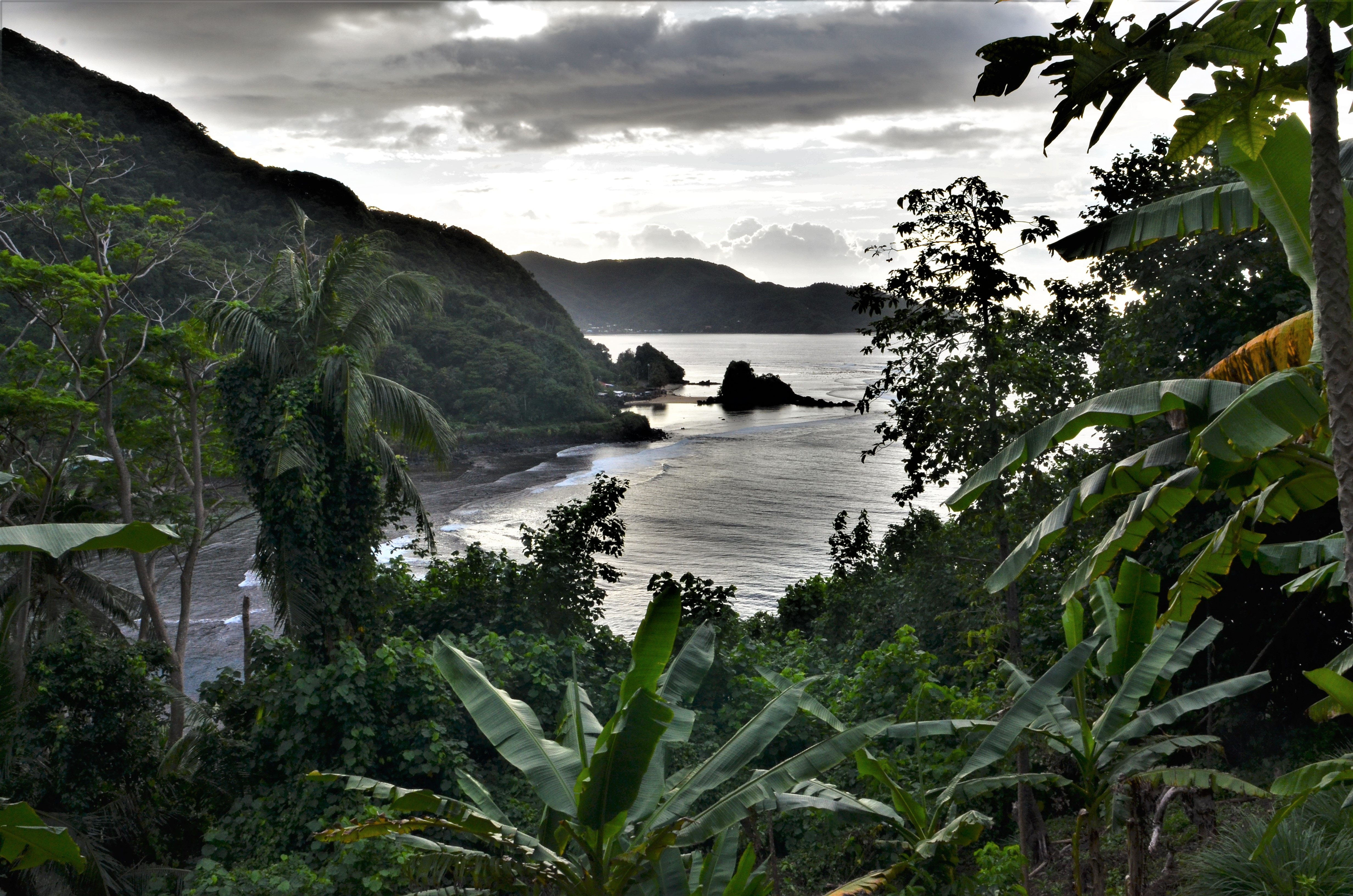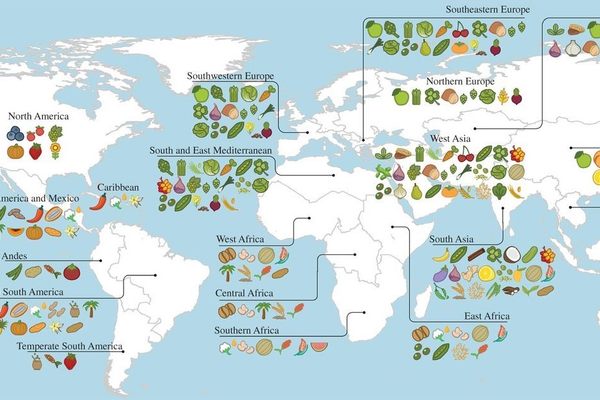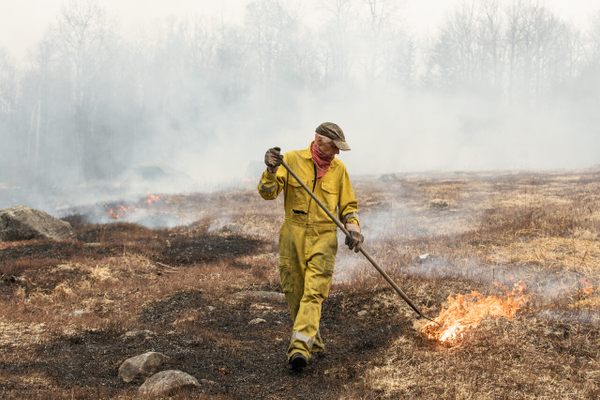One Man’s Quiet Quest to Collect Every Local Banana
In American Samoa, some delicious varieties are getting harder to find.

A ruddy stalk of oblong orange bananas hangs in the breeze at Tisa’s Barefoot Bar in Alega, American Samoa. Run by Tisa Faamuli and her New Zealander husband, known only as Candyman, this casual amalgamation of hut and patio, anchored by a few bottles of rum and one overworked blender, serves as an oasis for expats, sailors, and members of the island’s artistic community. If you ask Candyman about the prominently displayed bunch, you’re liable to be there a while. The ensuing tale spans centuries of history and migration, a treatise on vitamin C and potassium levels, with a cameo by the last great Tui of Manu’a.
This banana, known as the Soa’a, comes from the Manu’a Islands, a small archipelago about 70 miles east of American Samoa’s population center and territorial capital, Pago Pago. Candyman suspects it has a royal pedigree. “The Soa’a never spread to other Samoan islands, only on the King’s plantation on Manu’a. We think it came as a gift to the King, from some people coming from near the equator, and that’s why nobody else grew it,” he says. “I’m still looking for one more of the Soa’a [varieties]. We have two. There are roughly three.”
Candyman collects bananas. Acquiring a new one can be as simple as trading with the farmers next door. “I’ll be driving down the road and see a banana that I don’t have, and I’ll turn the truck right around,” he says. Occasionally he travels to outlying islands to identify varieties he hasn’t tried. Sometimes, it’s a matter of figuring out if what one farmer calls a “boiler” is really different from what another farmer calls the “goldenfinger.” When one plantation owner went to prison for assaulting a would-be banana thief with a machete, Candyman had to wait until the farmer returned from his five-year sentence to politely request an offshoot of his famed Misiluki banana.
“I found a survey conducted of the territory from the early 1900s that identified 35 different types of bananas,” says Candyman. To date, he has tracked down and cultivated 22 of those varieties on the volcanic hillside plantations he and Tisa manage above Alega Bay. He hopes to find all 35.

Candyman’s plantations are almost indistinguishable, to the untrained eye, from the emerald expanse of jungle that engulfs them. There are five, about an acre each, spread out across the hillside, chosen for sunlight, slight variations in soil quality, erosion control, and resilience to extreme weather. One snakes up behind the tiny gravel parking lot across from the bar. Another sits below a crest in the ridge that forms the village’s eastern border, sheltered from extreme weather. Except for one unsealed road, small footpaths connect the permaculturist patches of taro, breadfruit, lemongrass, and banana. “We make little footprints,” Candyman explains.
Of all his fruits, Candyman holds the little orange Soa’a in highest esteem. “The orange bananas I fell in love with because of the way they grew, the way they looked,” he says. “It took a long time to work out how to plant them. The pigs liked them, and the coconut crabs liked them, so I thought, there must be something good about those bananas.” A nutritional analysis conducted by a nonprofit in Pohnpei, Micronesia, confirmed the hunch: 7000% beta-carotene, 300% vitamin C, and 100% daily doses of potassium, respectively, a whopping improvement in all categories on the standard Cavendish, despite being a third of its size.
The banana draws interest at market, as well. “It’s definitely a money crop,” says Candyman. “I can put a bunch of Soa’a by the side of the road, and it’ll be gone in 10 to 20 minutes.” At four or five for two dollars, he sells them for four times more than an average bunch, although they take twice as long to grow.

Though he often waxes about nutrients and economics, Candyman’s plantations are ultimately the work of an exacting collector and archivist—a historical and culinary labor of love. “Most of the big banana plantations are out towards Leone, where the ground is more flat,” explains Candyman as he glides up the 50-degree incline of his Soa’a plantation, supported by his bare feet and a worn machete. “They grow four or five types for market.”
His Soa’a stand grows 12 feet in the air, creating a cathedral ceiling that shades taro saplings and razor-leafed Samoan pineapple underfoot. Candyman fells a big green bunch to be fried as banana chips for the guests accumulating at the beachside bar. He unceremoniously rips off fruit that’s stunted or has been nibbled by the island’s kite-sized fruit bats, shouldering the half-empty stalk and moving on up the mountain. “See, up and down this hill for only about five dollars worth of bananas. There’s no money in it!” he declares, with a gleam in his eye.

In 1994, Candyman came to Alega with a New Zealand contractor to install a water main. He met Tisa, who found him real sweet. She called him her “candyman,” and he’s been publicly known as such ever since. Candyman rigorously studied Samoan culture, agriculture, food, and language alongside Tisa’s father. “When I came to Alega, I asked Tisa’s father, ‘Why are there only four or five types of bananas in the village?’” says Candyman. “He told me, ‘Because those are the only ones that will sell at market.’”
An unincorporated U.S. territory of 55,000 people, American Samoa’s traditional foodways wash up against its economic development. Across the harbor from the open-air Fagatogo market, where people sell breadfruit, taro, and coconuts from backyard plantations, a Starkist tuna processing plant—the largest single employer on the island—hums with activity. Market shelves are stocked with long-travelled, subpar produce from the American mainland, and when sea cargo routes were interrupted in June 2018, due to a technical difficulty on an inbound ship, those shelves ran empty. Rates of diabetes and obesity are high, and fast food franchises such as Mcdonald’s and Carl’s Jr. do steady business. Some stores even import bananas. “At some markets they sell Chiquita bananas!” exclaims Tisa. “The ants won’t eat them. That’s when you know there’s something wrong!”

Candyman is an erect and somewhat ageless presence. He sports ubiquitous bare feet and is tattooed with the pe’a, the traditional full-body tattoo indicative of Samoan manhood, though as a foreigner, he is excluded from certain privileges, such as legally owning land. His wife Tisa moves with a similar grace, and together they have built an idyllic ecotourism-cum-environmental stewardship operation, including the bar and guesthouses, a yearly tattoo festival, a nonprofit marine sanctuary, and a work-training program for local youth. Tisa and Candyman’s fates aren’t tied to their plantations the same way previous generations of Alega’s residents have been. Instead, Candyman and Tisa farm to expand the flavors in their own kitchen and keep an edible record of the territory’s biodiversity and traditional foodways.
The flesh of their beloved Soa’a is an earthy, carrot-like orange. With a two-year fruiting period, a narrow harvest window, and a stunted size, it keeps you waiting. But at a dinner cooked by Tisa and Candyman in the traditional Samoan ground oven, or Umu, the diminutive fruit performs. In its peel on a bed of banana leaves over glowing rocks, the Soa’a becomes an ember of dank, molten concupiscence, its dense vegetal flavor rendered sweet by the fire and peppered with volcanic char. As I take it in, I recall one of the first distinctions Candyman pointed out about the stalk of Soa’a behind the bar. “It doesn’t bend to gravity, it stands straight up.”
Gastro Obscura covers the world’s most wondrous food and drink.
Sign up for our regular newsletter.











































Follow us on Twitter to get the latest on the world's hidden wonders.
Like us on Facebook to get the latest on the world's hidden wonders.
Follow us on Twitter Like us on Facebook